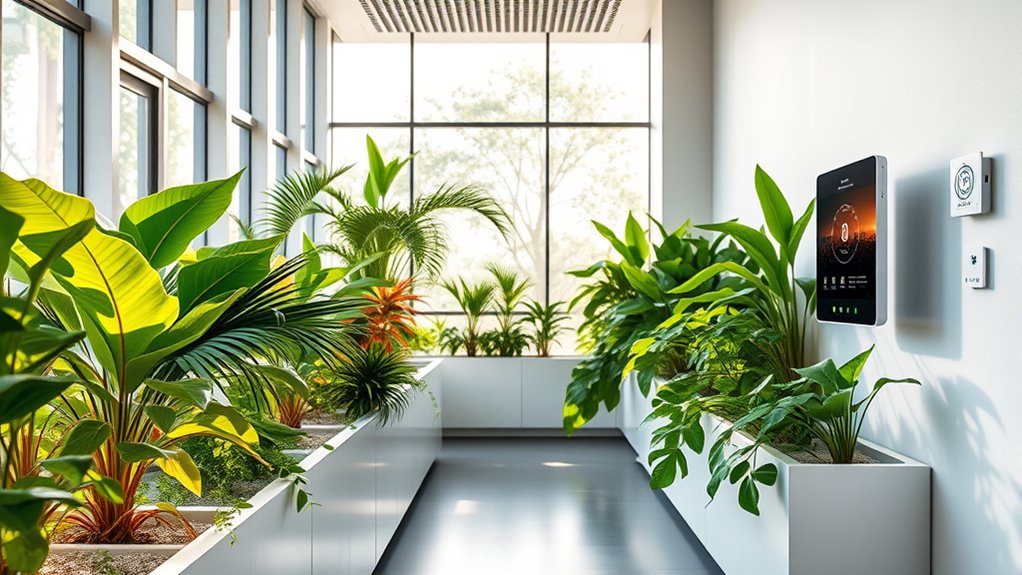A smart garden helps you automate your indoor jungle with easy-to-use technology. You can rely on automated lighting and watering systems that adjust to your plants’ needs, ensuring healthy growth without constant effort. Sensors monitor soil moisture, humidity, and temperature, giving you real-time updates and control via your smartphone. This creates a vibrant, low-maintenance oasis, making plant care simpler than ever. Keep exploring to discover how you can turn your indoor space into a thriving, automated haven.
Key Takeaways
- Automate lighting and watering with smart systems to ensure optimal plant growth and reduce manual maintenance.
- Use sensors and remote controls to monitor soil moisture, humidity, and temperature for a healthier indoor jungle.
- Customize environmental settings for different plant needs, extending growing seasons and improving vibrancy.
- Simplify plant care routines by synchronizing lighting, watering, and climate controls through integrated automation.
- Create a self-sufficient indoor garden, minimizing effort while maintaining lush, thriving plants year-round.

Have you ever wondered how technology can transform your gardening experience? With a smart garden, you can turn your indoor space into a thriving jungle without the constant fuss. Modern innovations make it easier than ever to care for your plants, saving you time and effort while ensuring they stay healthy and vibrant. One of the key elements is plant lighting, which can be automated to mimic natural sunlight perfectly. Smart grow lights adjust their intensity and spectrum based on the time of day or the specific needs of your plants, so you don’t have to worry about turning lights on or off manually. This consistent, optimized lighting encourages healthy growth and can even extend your growing season, making it possible to keep a variety of plants thriving year-round.
Alongside intelligent lighting, watering systems play an essential role in maintaining your indoor jungle. Automated watering systems are designed to deliver the right amount of water at the right times, preventing overwatering or underwatering. These systems use sensors to monitor soil moisture levels, so your plants receive hydration only when they need it. This not only conserves water but also reduces the risk of root rot or dehydration, which are common problems for indoor gardeners. You can customize watering schedules for different plant species, and many systems allow you to control and monitor everything via a smartphone app. This level of automation means you no longer need to remember daily watering routines or worry about forgetting to water your plants when you’re away.
Integrating these technologies creates a seamless gardening experience. With smart plant lighting and watering systems working together, your indoor garden becomes almost self-sufficient. You can set your preferences once and let the system handle the rest, receiving notifications if something needs your attention. This setup is especially beneficial if you’re busy or new to gardening, as it removes many of the traditional challenges. Plus, some systems even incorporate environmental controls, such as humidity and temperature sensors, further optimizing your plant’s environment. As a result, you gain more confidence in your gardening skills and enjoy more lush, healthy plants with less effort.
In essence, adopting smart lighting and watering systems turns your indoor space into an automated oasis. You get to enjoy the beauty and benefits of a thriving garden without the daily grind. These innovations help you stay consistent, prevent common mistakes, and create an ideal environment for your plants to flourish. Whether you’re an experienced green thumb or just starting out, integrating technology into your gardening routine makes caring for your indoor jungle more enjoyable, efficient, and rewarding. Additionally, understanding tuning concepts from vehicle modifications highlights how customization and precise control can significantly enhance performance and efficiency in various systems, including smart gardening setups.
Frequently Asked Questions
What Plants Are Best Suited for Smart Garden Automation?
When selecting plants for automation, focus on those with similar lighting needs and easy maintenance. Good options include pothos, snake plants, and philodendrons, as they thrive with consistent watering and moderate light. By choosing plants suited for your lighting conditions, you guarantee successful growth. Automation simplifies plant care, so you can enjoy a lush indoor garden without constant effort, making plant selection essential for a thriving smart garden.
How Much Does a Complete Smart Garden Setup Cost?
You’re curious about the cost comparison for a complete smart garden setup. The total price varies based on system size, features, and brand, typically ranging from $200 to over $1,000. The installation process is straightforward, often DIY-friendly, but some setups might require professional help. Keep in mind, investing in automation can save time and improve plant health, making it a worthwhile upgrade for your indoor garden.
Can Smart Gardens Be Used Outdoors Effectively?
You might find it surprising, but smart gardens can be quite effective outdoors, thanks to their outdoor resilience and weather adaptability. With the right setup, you can enjoy automated watering, lighting, and monitoring even in changing weather conditions. Just make certain your smart garden system is designed for outdoor use, providing protection against elements like rain and wind. This way, you get all the benefits of automation while thriving in your outdoor space.
What Maintenance Is Required for Automated Garden Systems?
When maintaining automated garden systems, you need to regularly check and adjust watering schedules to guarantee your plants get the right amount of water. You should also monitor for pests and manage them promptly to prevent damage. Keep your system’s sensors clean and update the software as needed. By staying attentive to these tasks, you’ll keep your garden healthy and thriving with minimal effort.
Are Smart Garden Systems Energy-Efficient and Eco-Friendly?
Think of your garden as a thriving ecosystem, where energy efficiency and eco-friendliness are its heartbeats. Smart garden systems often harness solar power, turning sunlight into power to reduce reliance on grid energy. They also promote water conservation by optimizing watering schedules, conserving resources like a gentle rain nourishing the earth. This eco-conscious approach helps you nurture your indoor jungle sustainably, making your garden a symbol of harmony with nature.
Conclusion
With a smart garden, you’ll seamlessly simplify your space, sparking a stunning, self-sufficient sanctuary. By blending brilliance with basic botany, you’ll boost your botanical bliss and bask in the beauty of a blooming, balanced indoor jungle. So, step into this sustainable, tech-savvy transformation and turn your tiny turf into a thriving, lush landscape. Embrace the ease, enjoy the elegance, and elevate your environment effortlessly with your smart garden’s savvy solutions.









